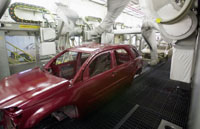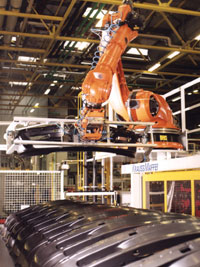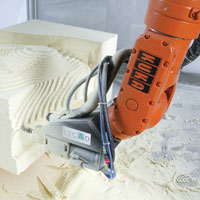Staying Ahead With Machine Tools And Robots
Productivity advances resulting from the technology revolution are reshaping global competition.
By John Teresko
To play in global markets, the game for manufacturers is to stay ahead of the competition -- as in this old African proverb:
"Every morning in Africa, a gazelle wakes up.
It knows it must run faster than the fastest lion or it will be killed.
Every morning a lion wakes up.
It knows it must outrun the slowest gazelle or it will starve to death.
When the sun comes up, you'd better start running."
Running unaided is out. Winning in manufacturing, ultimately, is determined by how fast you can run while armed with the latest technology.
For example, Oxnard, Calif.-based Haas Automation Inc. reported record production numbers and shipments for the first half of 2006. Small job shops typically comprise as much as 70% of the customer base, says Jeff Law, sales and product manager for horizontal machining centers.
But even as the industry revels in the new levels of machine tool investment, there are plenty of reasons to push on with the technology race. One is the potential for competitive gain among U.S. manufacturers. For example, notes John B. Byrd, III, president of the AMT, the average age of machine tools on U.S. plant floors is 12 years. Then, too, consider that China's machine tool investments are racing ahead of the U.S. without any signs of slowing. In 2006 China's cumulative investments in machine tools since 1998 will exceed that of the U.S., Byrd notes. In 2005 China invested more in machine tools than the U.S. -- $10.9 billion vs $5.8 billion. (China consumes 21% of the world's machine tool production, according to the AMT.)
A record trade surplus is one metric of China's competitive race strategies. On July 11, the New York Times reported "the largest monthly trade imbalance any country has ever recorded. . . . The surplus in June reached $14.5 billion, a record for the second month in a row, eclipsing each of the giant surpluses recorded by Japan in the last few decades."
Technology, Jobs And Productivity
China's embrace of the latest production technology challenges the traditional U.S. job loss discussion. "Jobs are not going to China simply because of cheap labor," Byrd points out, arguing that global competition via technology-driven productivity is the new job-loss factor.
 Robots quickly became essential to auto production -- as with this Fanuc Robotics P-500 paint line -- but non-automotive applications are growing rapidly.
Robots quickly became essential to auto production -- as with this Fanuc Robotics P-500 paint line -- but non-automotive applications are growing rapidly.
Byrd refers to a fundamental transition that is accelerating among U.S. manufacturing's top performers. "Manufacturing employment has fallen some 20% over the last two decades. The reason is the tremendous, continuing rise in productivity, allowing fewer workers to produce more goods, faster and at lower cost." In that evolving scenario, technological innovation -- not local wage rates -- determines competitiveness via productivity. Reducing labor content becomes an important competitive tool and he who plays technology best wins, adds Byrd. Low labor cost countries are not always the competition, adds Donald A. Vincent, executive vice president, Robotic Industries Association, Ann Arbor, Mich. In China, that kind of job loss is celebrated for the performance attributes it implies -- lower cost and increased capacity. The added productivity increases China's capacity to satisfy burgeoning demand.
Byrd suggests reevaluating the issue of job loss. His point: Reduced labor content (i.e., fewer jobs) can be a natural outcome of winning through technology. Byrd cites agriculture as one example: "In 1900, 40% of the U.S. workforce was involved in agriculture, while today it is less than 2%, but you can't say agriculture is dying. For another good example, look at technology's impact on telecommunications. In the 1970s approximately 421,000 switchboard operators handled almost 10 billion calls. Today operators number only 78,000, but they handle 100 billion calls." Byrd's point is that productivity advances are one inevitable way the technology revolution reshapes global competition.
The productivity of the latest machine tools and robots helps counter more than spiraling wages and benefits. Corporate taxes are another issue, and these costs should not be considered inconsequential, Byrd advises. "In one study of the nine largest trading partners, U.S. manufacturers had a 22.4% competitive disadvantage," he notes. Corporate cost pressures in the same study, conducted by the National Association of Manufacturers (NAM) and the Manufacturers Alliance/MAPI, also included litigation costs, pollution abatement and natural gas prices.
 However, productivity has made a strong showing as more and more labor is taken out of the product. Byrd offers as an example, "Between 1992 and 2004, manufacturing productivity grew over 60%. And if you look at the last four years, it has grown 25%."
However, productivity has made a strong showing as more and more labor is taken out of the product. Byrd offers as an example, "Between 1992 and 2004, manufacturing productivity grew over 60%. And if you look at the last four years, it has grown 25%."
Substantial advances are even evident within equipment categories. In one study an AMT member compared the evolution of vertical machining centers between 1992 and 2004. They found that the price of the equipment category remained essentially flat in spite of inflation. During that same period, the more modern machines became between 50%-70% more productive, depending on the complexity of the part.
Byrd's conclusion: The market is confronting a totally different financial justification. Winning the competitive race means new job circumstances -- less labor content, but typically with a higher skill requirements. "So the premise that all the 'good' jobs are going offshore is false," he notes. "Basically manufacturing is going through the same stage that agriculture went through and that telecommunications went through -- which is really finding ways of taking labor out of the product."
Replacing just half of the installed base that is older than 12 years would result in greatly increased productive capacity, but with proportionately fewer jobs, Byrd observes, adding that the jobs that are left will be much more technically demanding. "Even today, close to 50% of the production employees have some college education, with 25% having a college degree."
Byrd does describe job loss as a challenge, but only insofar as whether technology will be able to cut labor needs enough. He cites a workforce study of the next two decades that suggests that the U.S. may be challenged to replace even half of those that retire.
Winning Technologies
AMT's Byrd traces the rapid growth of machine tool performance and productivity to two events: the advent of electronics -- specifically, numerical control (NC) -- and the introduction of multitasking machines. "Electronics, via digital control technology, accelerated performance optimization in terms of machine precision, speed and throughput," adds Rich Curless, vice president, technology development for Cincinnati Machine, Hebron, Ky. His examples include faster communication between the machine tool mechanisms and the capability to allow parallel activities instead of just sequential activity of machine mechanisms. "That accelerates both work and tool changing and also facilitates getting spindles up to speed and into the cut faster," Curless notes. "That reduces parasitic (non-cut) time substantially."
|
Machine tool leader Mazak Corp. introduced multitasking by marrying an automatic tool changer and two-position spindle with a slant-bed lathe. While a powerful new way of thinking about machining processes was born, the challenge of designing for the multitasking capability is ongoing, says Brian Papke, president. The goals of multitasking include the following:
|
Dramatic efficiencies also became a competitive tool when Mazak Corp., Florence, Ky., introduced the multitasking machine tool concept. The time was 1983 and the idea was to combine capabilities into one machine tool that once required multiple fixtures and setups on separate machines, says Brian Papke, president (see "Key Benefits of Multitasking. ")
The initial design married an automatic tool changer and a two-position spindle with a slant-bed lathe. A current model, the Integrex, has five-axis machining center capability with two spindles and is available with additional turrets. As a fundamental productivity advance, Papke rates multitasking with the earlier development of machining centers. (In one instance, a Mazak customer was able to use two multitasking machine tools to replace seven conventional machine tools, says Papke.)
Lower capital investment is the net effect of the new capabilities and efficiencies of machine tools and robots, adds Curless. He references aerospace operations, where as many as 14 setups may be necessary to get to a finished part. "With today's technology fewer setups, fixtures and even machines will be required." Haas Automation's Jeff Law cites one customer where one new horizontal milling machine replaced four.
Equipment costs have remained fairly flat, but more needs to be considered to analyze the manufacturing context for the best implementation of new machine tools or robots. "You've got to look at the whole set of requirements needed to produce that part," Curless explains. The roster includes programming personnel, fixtures, tooling, installations, training and cutting fluids. He offers this rule of thumb: "The investment by a manufacturer to produce a part -- the capital equipment and what's needed to get it up and running -- will be double the cost of the equipment."
Digital Manufacturing
More manufacturers are turning to software tools to help design manufacturing strategies, says Robert Axtman, executive director of worldwide marketing for Auburn Hills, Mich.-based Delmia Corp. His example: Sanyo Machine Works and its use of Delmia Simulation tools provided by a Dassault Systèmes product lifecycle management (PLM) solution. By simulating the manufacturing processes in a virtual factory environment, this digital manufacturing solution is able to validate equipment layout, robot reachability, cycle times and ergonomic factors such as worker posture. The strategy has helped reduce lead-time, eliminate parts, streamline manufacturing and improve quality.
 The digital manufacturing approach won strong support in a study by manufacturing consultants CIMdata Inc., Ann Arbor, Mich. According to the study, "On average, organizations using digital manufacturing technologies can reduce lead time to market by 30%, the number of design changes by 65% and time spent in the manufacturing planning process by 40%. Production throughput can be increased by 15% and overall production costs can be cut by 13%."
The digital manufacturing approach won strong support in a study by manufacturing consultants CIMdata Inc., Ann Arbor, Mich. According to the study, "On average, organizations using digital manufacturing technologies can reduce lead time to market by 30%, the number of design changes by 65% and time spent in the manufacturing planning process by 40%. Production throughput can be increased by 15% and overall production costs can be cut by 13%."
One caveat: The greatest gains are typically achieved in large scale, complex and/or difficult environments. CIMdata's advice: for maximum benefit, digital manufacturing software should be implemented as a component in an end-to-end, comprehensively integrated PLM solution. "It should be based on a process orientation and include re-engineering of processes as part of the software implementation," the consulting firm explains. "If implemented as stand-alone point solutions, significantly lower payback can be expected."
At Autotool, an automation system design specialist, the Delmia simulation tools create "what if" scenarios on an existing line to analyze equipment options. By creating a mockup design of the line, simulation can be used to study a number of new production scenarios, including the addition of capital equipment as well as changes in the existing process. Autotool can quickly analyze where new equipment can be placed in relation to the robots to make sure there are no collisions and avoid any investment in unnecessary capital equipment.
By analyzing different scenarios, simulation of up-front processes can help eliminate investment in unnecessary capital equipment. One user states the number of welding guns was reduced from 180 to fewer than 20.
Delmia's Axtman positions digital manufacturing as an enabler for the pursuit of lean manufacturing and Six Sigma. "I advise companies if they're not using digital manufacturing solutions, they're not truly conforming to the principles of lean or Six Sigma."